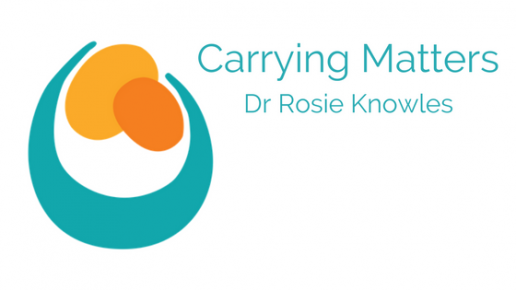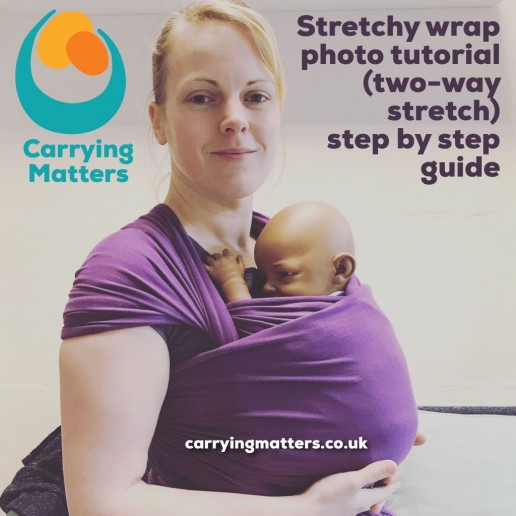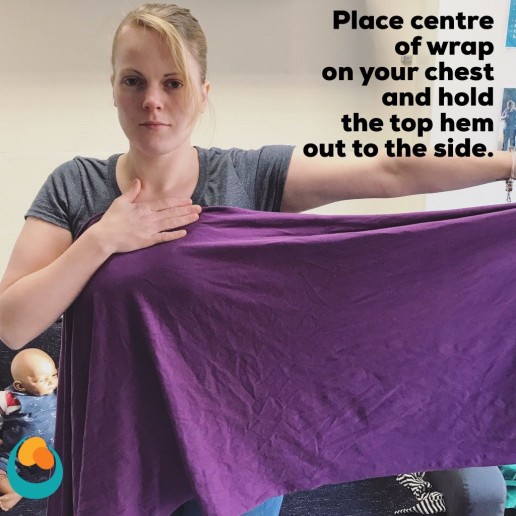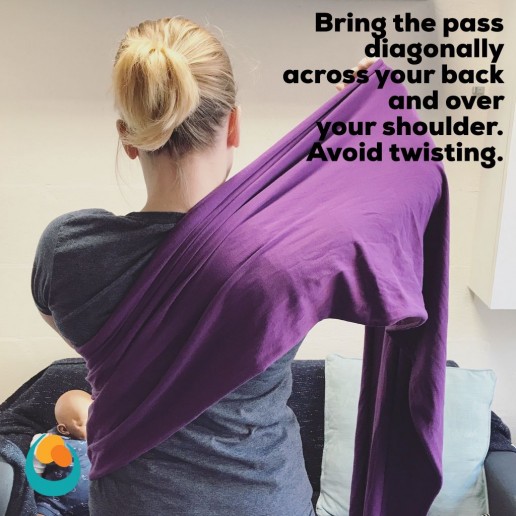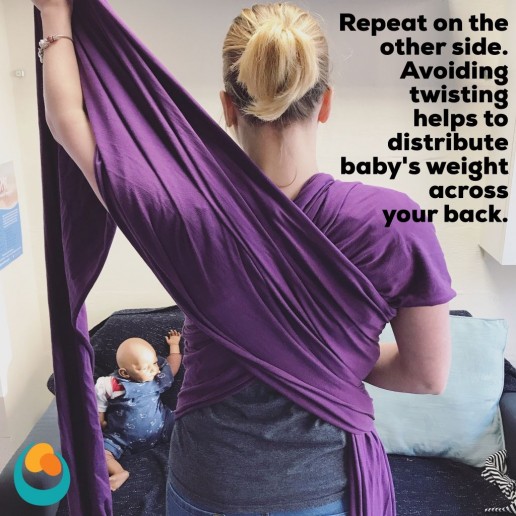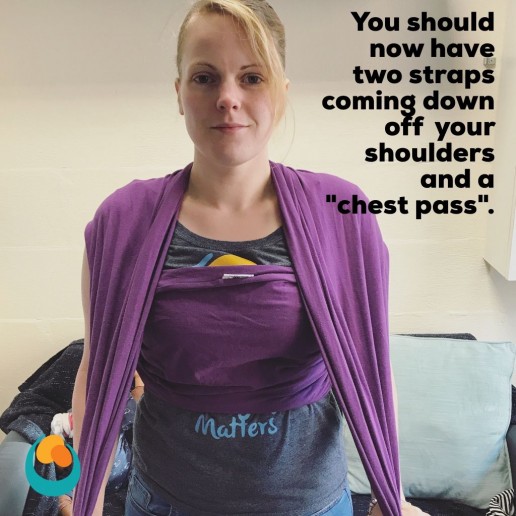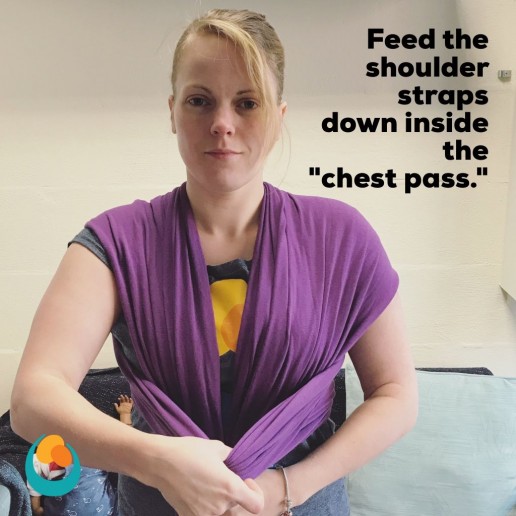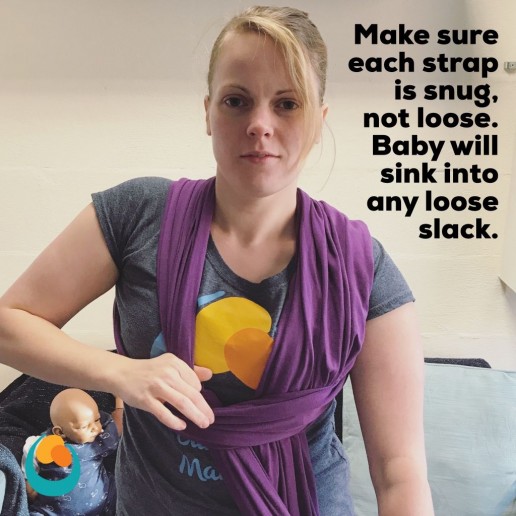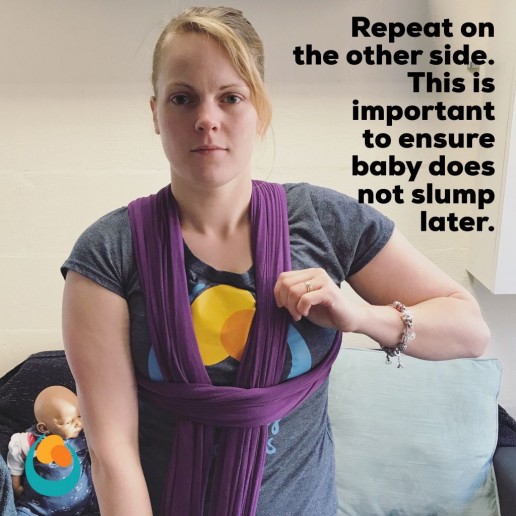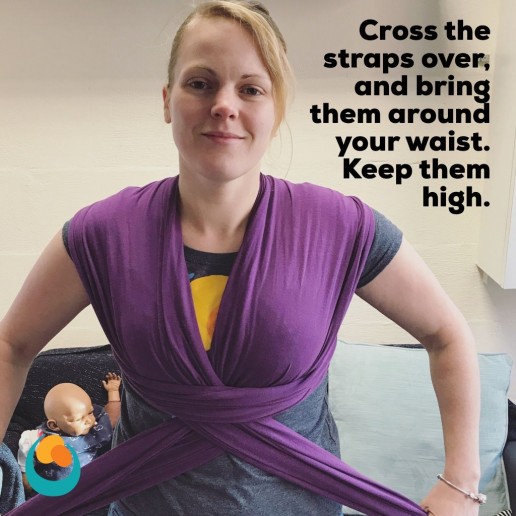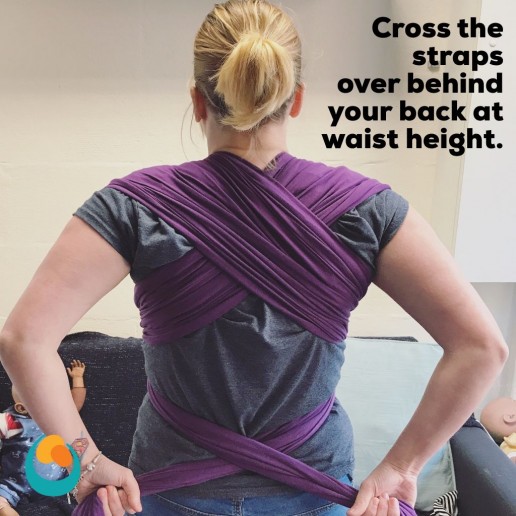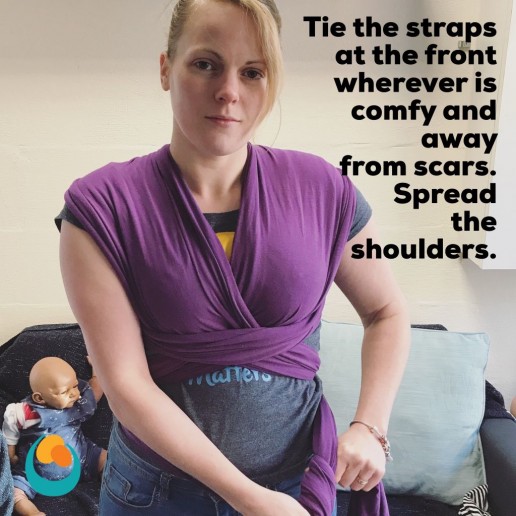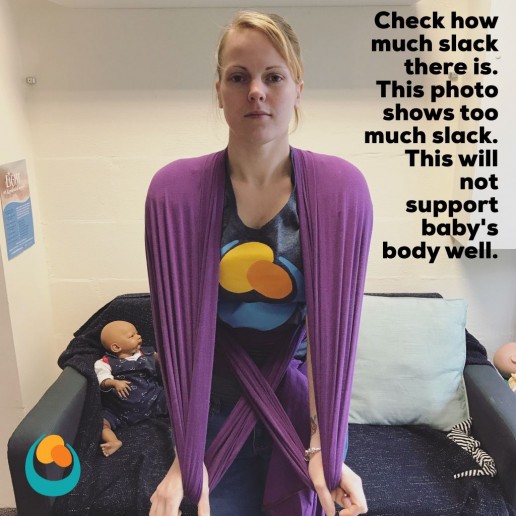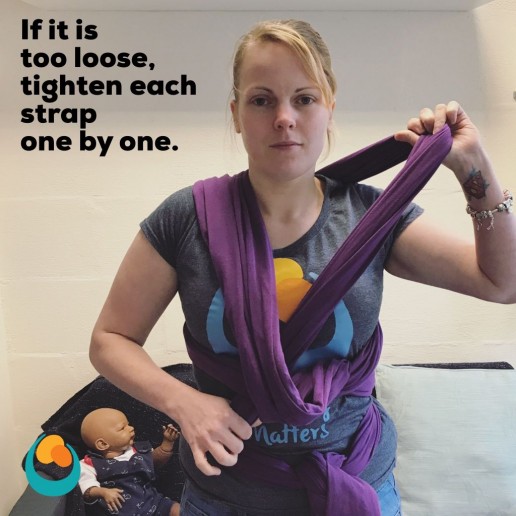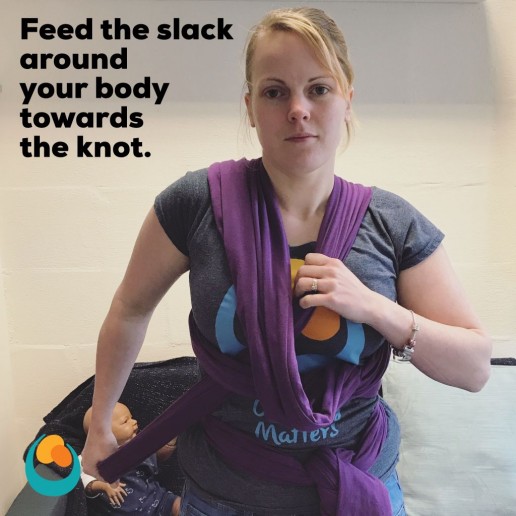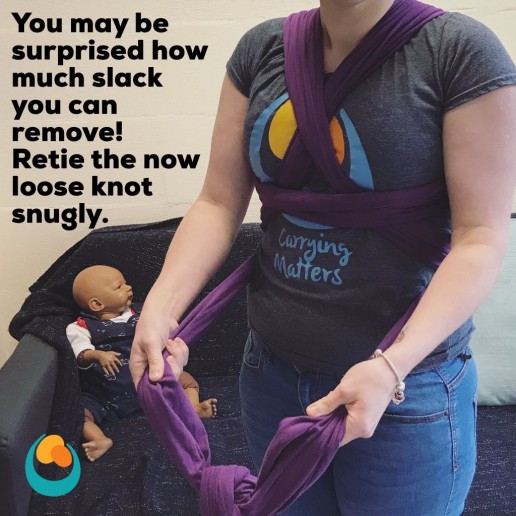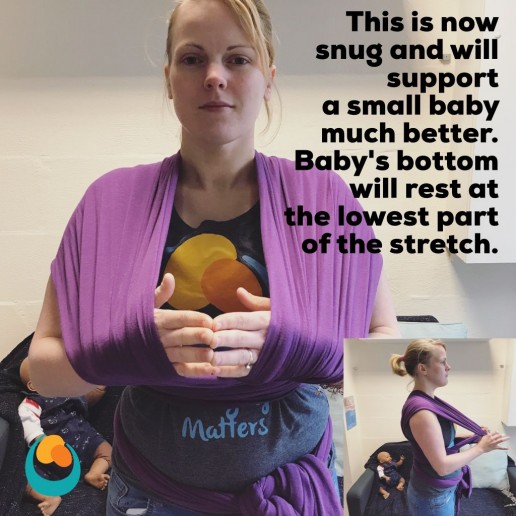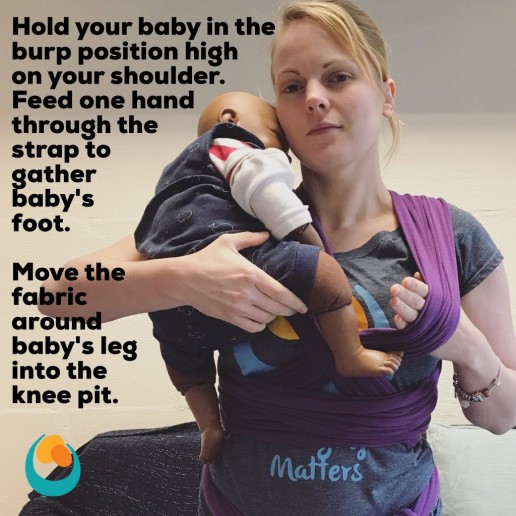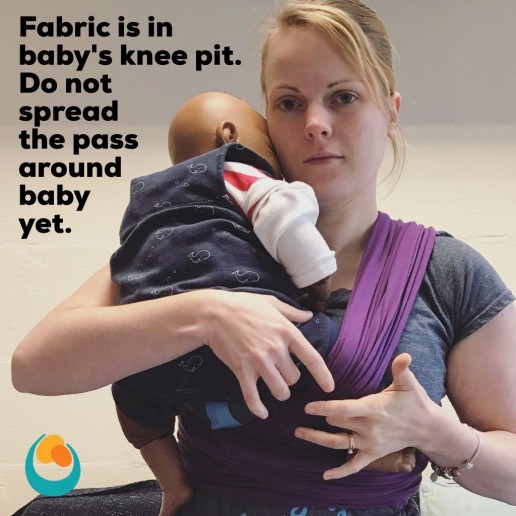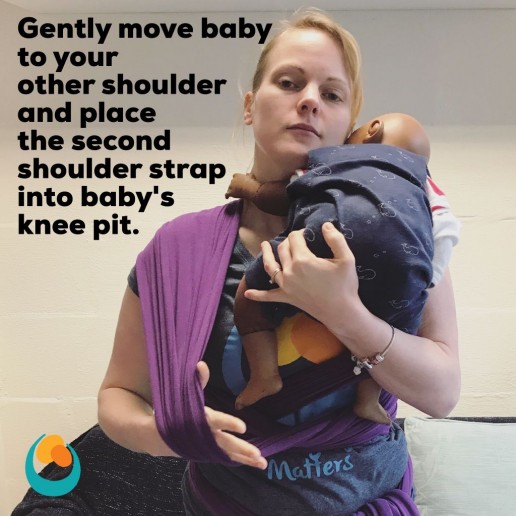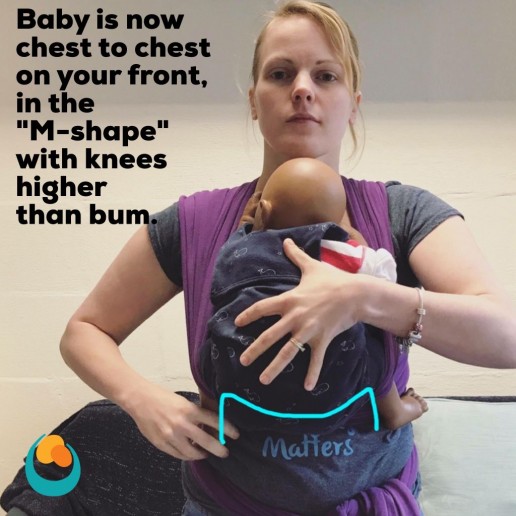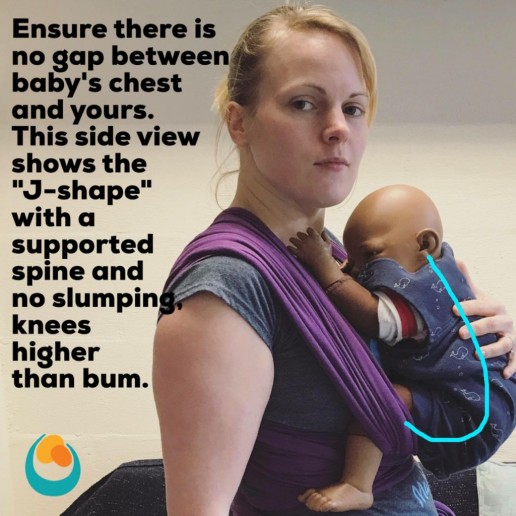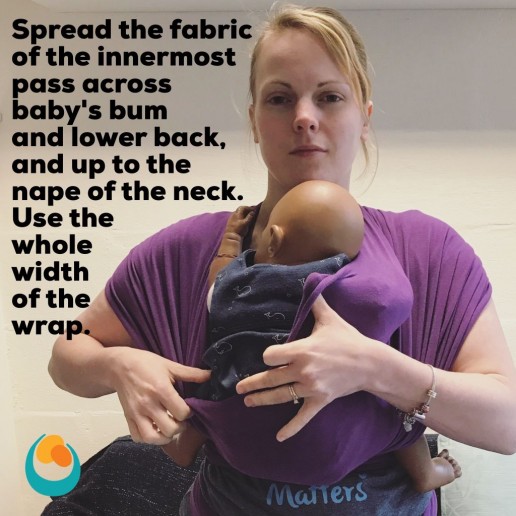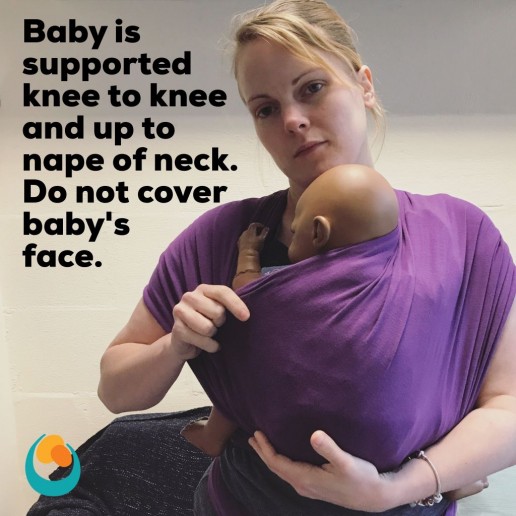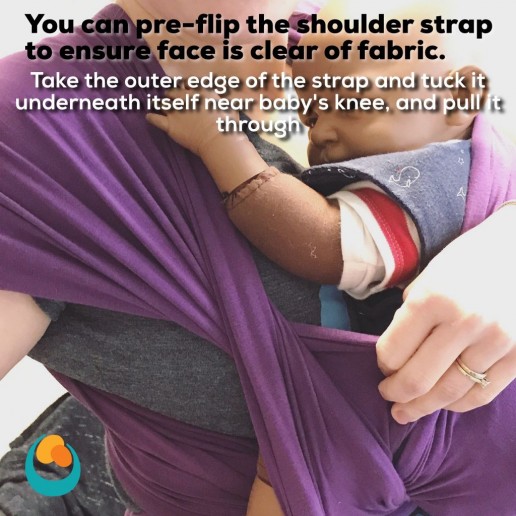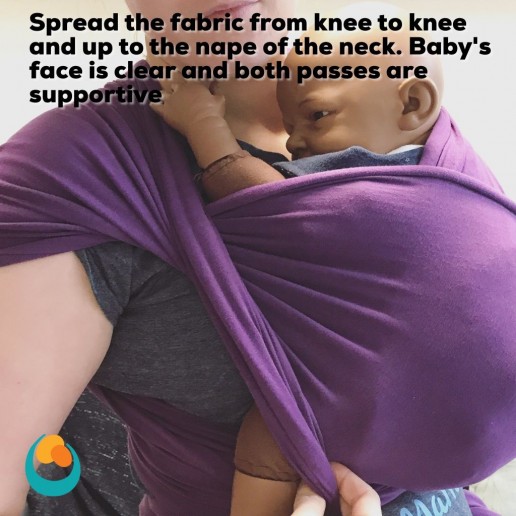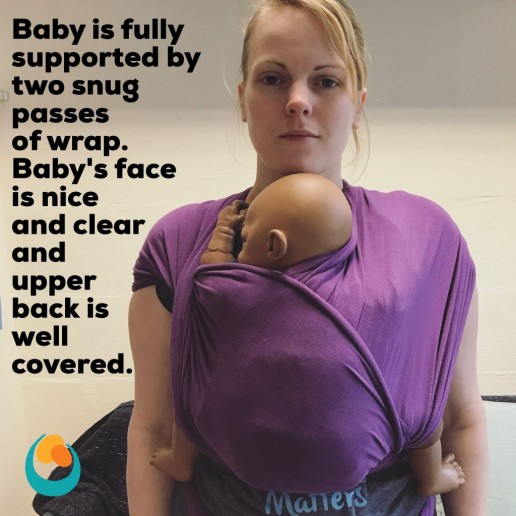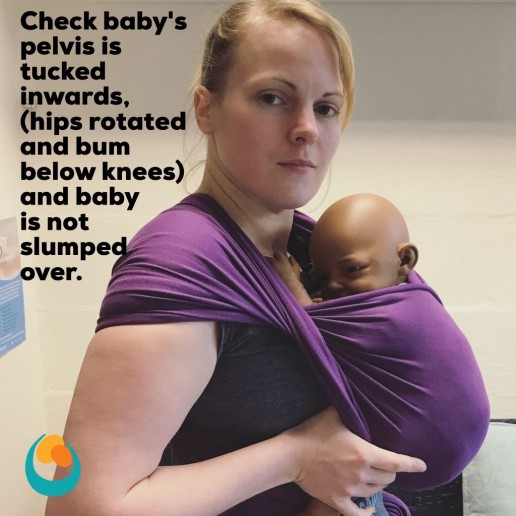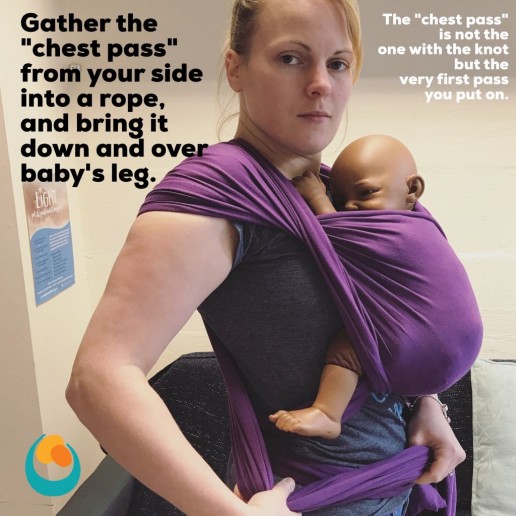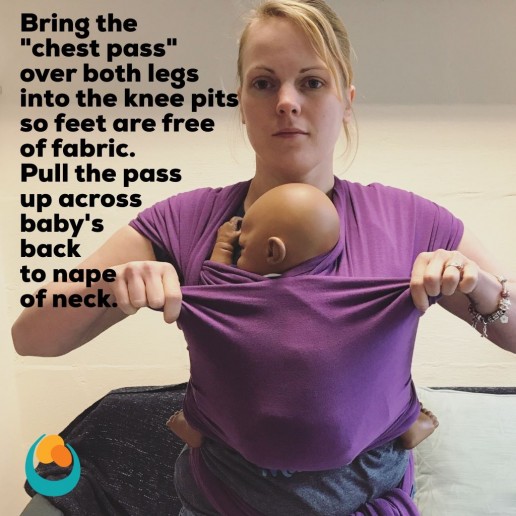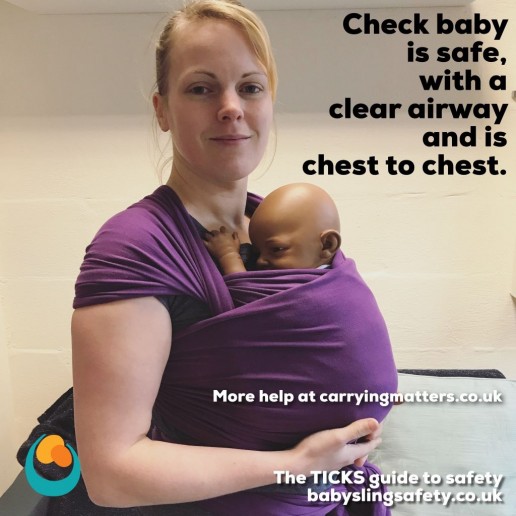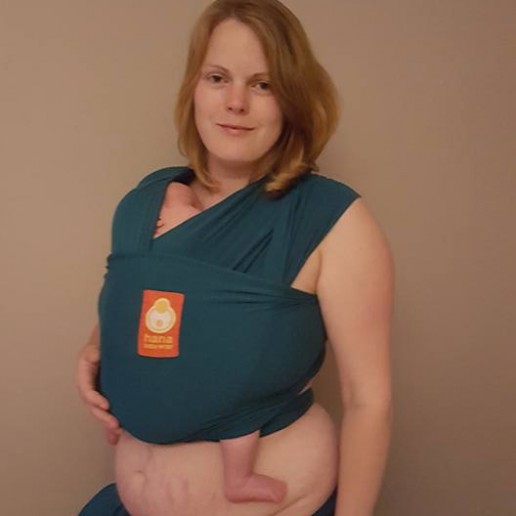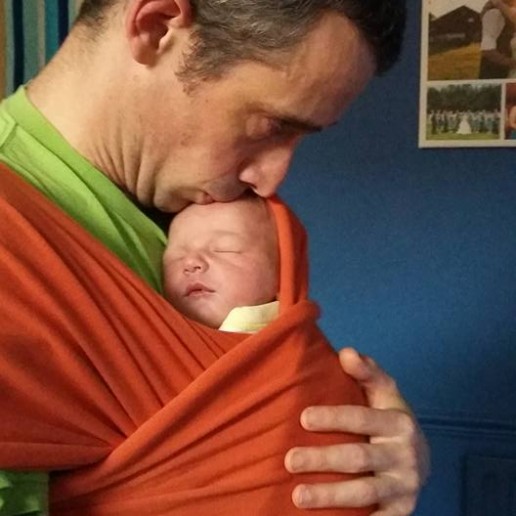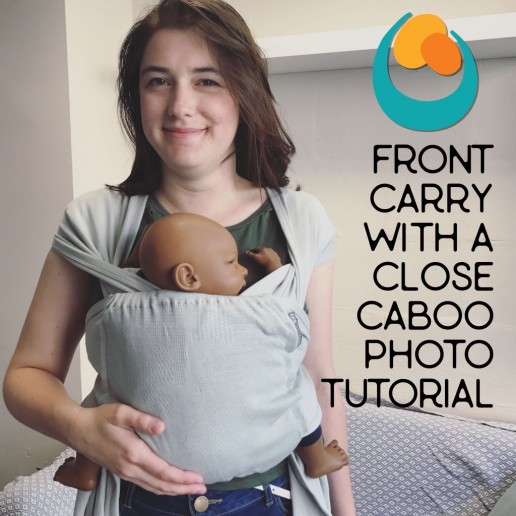I am a big fan of stretchy wraps and their variants (like the Close Caboo). They come in all shapes and sizes, and are usually to be found cuddling a tiny baby close to someone’s chest. Many babies adore the security and safety of the wrap and fall quickly to sleep. For many parents, they are the first slings they own, for good reason.
Like all carriers, stretchy slings need to be used safely and the TICKS guidelines should always be followed. The most important consideration is to protect baby’s airway; a baby’s neck should never be folded in half and two fingers should fit between their chin and their chest.
The most frequently adopted position for carrying is upright and facing in, with legs slightly spread apart (the M position) and head well supported, as this will also protect growing hips and spine. The stretchy wrap will provide gentle mouldable support and can be adjusted to provide head support.
Babies often sleep in stretchy wraps/Close Caboos, when well positioned, as the closeness and snuggliness of the layers of fabric (always at least two layers of fabric with a stretchy!) mimic the close conditions of the womb during pregnancy, and being in contact with a parent’s skin and near a parent’s heartbeat and able to hear a parent’s voice is extremely reassuring for babies.
The most common style of carry is the pocket wrap cross carry (where baby’s legs are on either side of two cross passes). Once you have the hang of it, it is quick and easy, and the wrap can be left on all day and baby popped in and out.
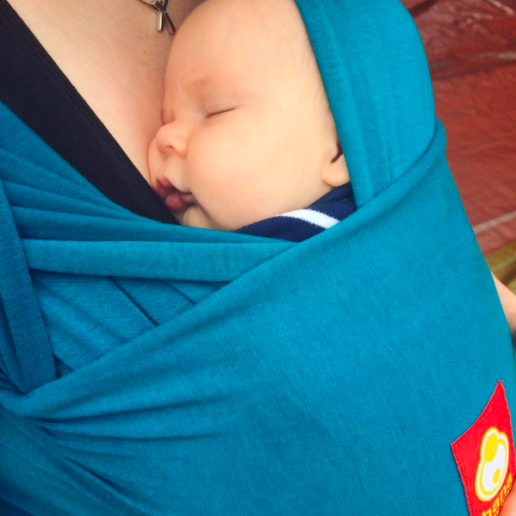
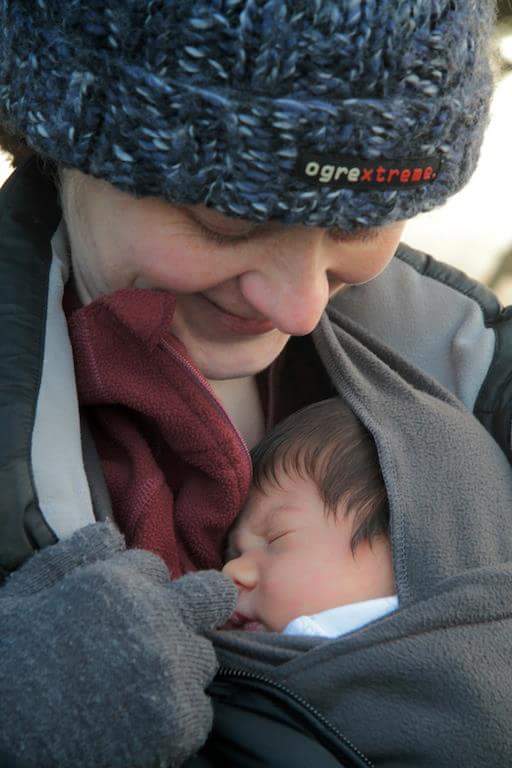
What is a Stretchy Wrap? (see further below for the Close Caboo)
A stretchy wrap is a length of fabric, usually made of soft and stretchy machine knitted cotton, that is usually between 4 and 5m long and about half a meter wide. Some have bamboo blended in with the cotton, which adds to the softness and comfort, and some have a small proportion of spandex, which adds to their elasticity and stretch.
They are suitable from birth, and in fact are often used for kangaroo care in hospitals with premature babies, and most people will find their stretchy wraps will be suitable for at least six months and often many more, especially for the days when active babies are sad and need all-over-cuddles or need some sleep. The gentle all-round pressure helps to reduce excessive stimuli and allow a baby to switch off and sleep.
Not all stretchy slings are the same (varying in stretchiness and ease of use) but by and large, they have the same purpose – to be a comfortable one-size-fits-most sling that a parent can pre tie before putting baby in. This means that the sling can stay on all day and baby can be tucked into it easily and quickly when needed, and taken out again very simply. There is no need to retie a stretchy over and over again during the day. The stretchy does not need to be removed for breastfeeding (see below for how to do this safely).
How do I put my stretchy on?
The key to success is in preparation; getting the tension of the passes right before baby goes in, and ensuring their position is correct. I always recommend that each pass is in place in baby’s kneepits to ensure baby is in the M shape and held chest to chest before the fabric is then spread across their body, one side at a time. These images show optimal positioning for a young baby in the wrap – each kneepit is supported in the M shape and baby is chest to chest in the gentle J shape.
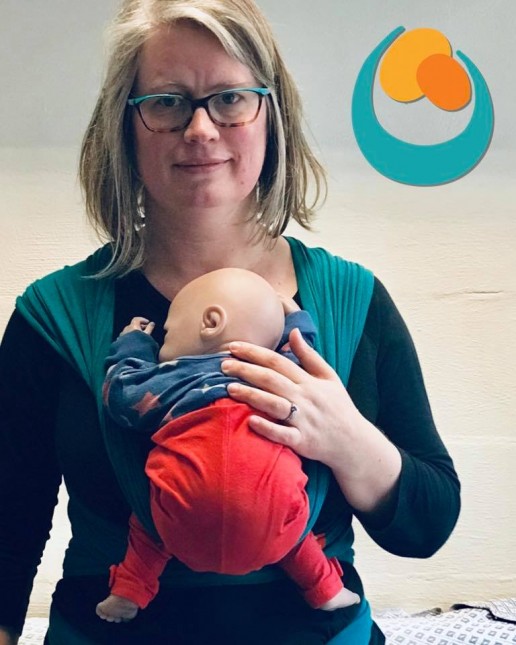
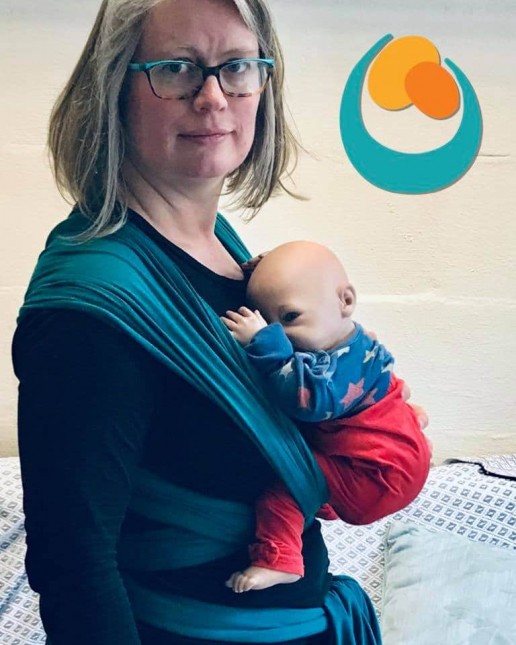
Here is a quick subtitled video showing how a young baby can be positioned well.
Many people worry that it looks fiddly, complicated or that there is too much fabric. But really, it is simple – you just tie it on the same way each time and pop baby carefully into the cross passes on your chest. The videos here all show just how simple it can be. I work with “two-way” stretchy wraps (they stretch lengthways and widthways and are easy to maneouvre).
With premature or especially small babies who still have their feet held very close to their bodies, other techniques (still using the same tie method) may be more suitable, such as this one (video link). Please get in touch with your local sling educator (www.slingpages.co.uk) for extra help.
Please note that horizontal cradle style carries are no longer recommended due to airway risk. Some older instructions unfortunately still contain this position.
Here is another video of the pocket wrap cross carry from Noah’s Arc Sling Library
And here is an audio described version of the above
A step by step stretchy wrap photo tutorial guide; this is a two-way stretchy wrap. Two-way stretchy wraps stretch along their width and their length.
The key to success is in preparation; getting the tension right before baby goes in, and ensuring their position is right before spreading any fabric. Quick link to this tutorial here.
Video of the Pocket Wrap Cross Carry with a two way stretchy wrap (Hana, Boba, JPMBB), showing how to avoid slumping. This is the same technique as the photo tutorial.
A more detailed, slower video with doll can be seen on this YouTube link
How to take a baby out of a stretchy wrap without untying – this allows the wrap to stay on all day and baby can be popped in and out, rather than retying over and over again.
A short video for how to do the pre-flipped shoulder to keep fabric away from baby’s face. This is important to ensure there is no airway obstruction.
The pelvic tuck with stretchy wraps (and all carriers) is important, for baby’s airway support and also for comfort.
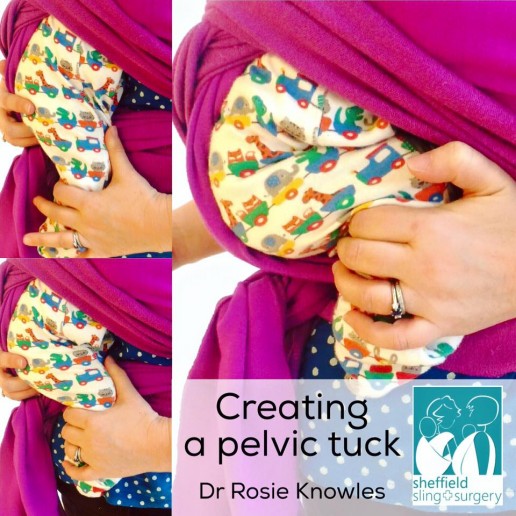
Passes in knee-pits and good M shape position
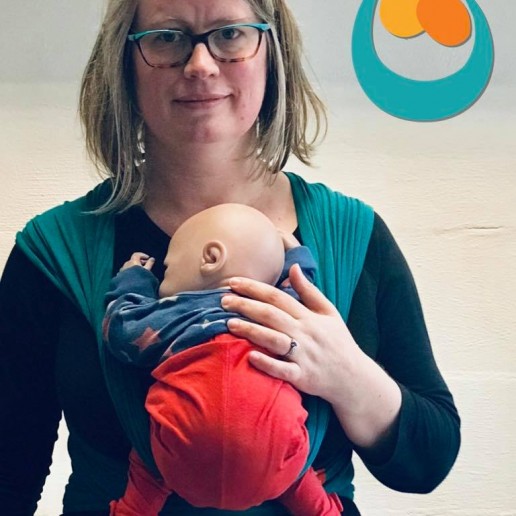
Top Tips!
- Make sure the fabric is snug. Slack fabric leads to slumping later. Take time to make sure all the passes are tight and when stretched out, are no looser than the volume of your baby's body.
- It will be much easier if you hold your baby in the secure M and J shape positions onto your chest before you put the carrier on.
- Put both baby's legs into each cross pass and ensure he is sitting down with the passes in his kneepits, and then straighten him up and check his position. His ribcage should be snug against your chest and his chin up.
- Then spread each pass one by one, kneepit to kneepit (this avoids sideways slump).
- Ensure there is no fabric over your baby's face; fold the fabric out of the way, ensuring each pass still comes up to the neck.
- Pull up the third pass to the back of baby's neck. Some people will fold the top edge over a rolled up muslin to provide a little extra neck support for active babies.
- You should feel like you can lean forwards (with one hand on baby's head) and baby should not swing free.
Common Queries about Stretchies
Breastfeeding in Stretchies
It’s possible to breastfeed in a stretchy, once feeding is well established and you are confident with your use of the sling. The video below shows you how you can use your stretchy as an aid for feeding without needing to unwrap each time. Please note that baby’s head is not covered by fabric and her neck is supported throughout. When baby has finished feeding, she must be returned to her safe upright position and not left to sleep in the horizontal position.
No breastfeeding is hands free, and it is usually a good idea to get some help and advice from people who are familiar with how to do it.
Can I face my baby outwards with the stretchy?
Forward facing out in a stretchy is not recommended for several reasons, even though some older instruction manuals show how to do it. Newer companies do not have this carry in their instructions. Why not?
- No head support can be created in this position, and babies have heavy heads in proportion to their bodies. A sleepy head lolling forwards may compress the airway and impede breathing, just as the cradle carry may do.
- A baby facing out has no support for the hips and legs (see this article for more)
- The spine is artificially straightened in the forward facing out position when it should be curved.
- Babies do not have the ability to “zone out” from all the conflicting sensory streams that comes from being held facing out. They need to be able to switch off and rest against a reassuring parent; this is hard to achieve facing out.
Read more here about facing out carriers; this can work well with older children.
How long will I be able to use my stretchy wrap?
That depends on the stretchy. Many people find that as babies get bigger and want to be able to see the world around them, they can find the all-over cuddle of the wrap a little restrictive for seeing. At this point, opening the shoulders out can help with visibility, but do keep a hand near any wobbly heads. Stretchies are great for older babies who are sad or uncomfortable and want a cuddle, or are ready for a sleep.
Most people will find the stretchy wrap works very well for the first six to nine months of age (a few will last into toddlerhood), and is just the start of a happy babywearing journey as their baby grows bigger. At this point, parents may begin to consider other carriers that have a wider vantage point. Some will allow more open shoulder strap angles, some will allow hip carrying, (such as ring slings or the Scootababy) and back carrying may not be far off!
Troubleshooting your Stretchy Wrap
- Feeling too tight? Baby should be close enough to kiss, able to rest his head on your upper chest just under your chin. You should feel able to take a deep breath without feeling constricted (one hand's breadth between your baby's ribcage and your chest.) Any looser and baby may begin to slump. You can often lower your baby by putting your hands inside the carrier under her bum and bringing her down a little. Many stretchy wraps will have a little give in them and as you walk, baby is likely to settle down a little lower naturally.
- Too loose or too low? Your stretchy is likely not tight enough; retie or see the video for how to tighten.
- Baby slumping to one side? This can be avoided by putting baby's legs into each cross pass in turn, just into the knee pits, and ensuring he is positioned right before you then spread each pass.
- Baby seems to be too curled up or folded inside the stretchy? This is likely due to the fabric not being snug enough, see the video for how to "unfurl" a slumping baby to keep their chest cavity well supported.
- Baby's face buried in fabric? Ensure stretchy is snug (looseness leads to slumping over. You can fold or flip the shoulder passes (see photo below) for airflow and visibility, and use the other side as a hood if tolerated.
- Baby wants to lean back and look at you? You can use a rolled up muslin folded into the top section to provide some neck support.
Unfurling a slumped baby
Stretchy too loose or too low and don’t want to re-wrap? Here is how to tighten it up to get baby back into a safe position.
Folded shoulders for airflow and a hood
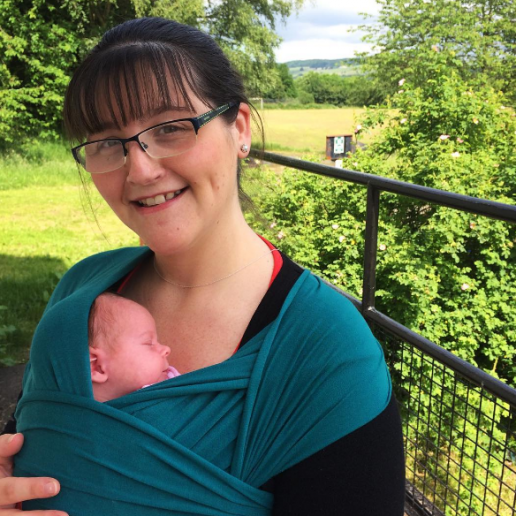
A rolled muslin forming a neck support
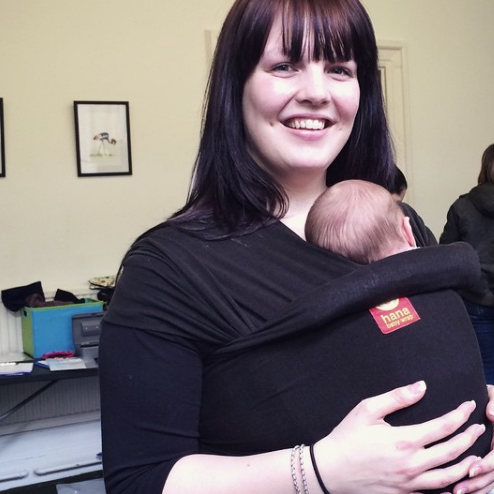
More videos (for one way stretchy wraps like the Moby) or the pocket double hammock carry for babies who prefer to be legs in can be found here on the videos page.
Carrying twins in a stretchy wrap
Many parents of twins will use a good, supportive stretchy wrap to carry their small twins, with one twin in each cross pass. It can take a little practice, do come and get some help!
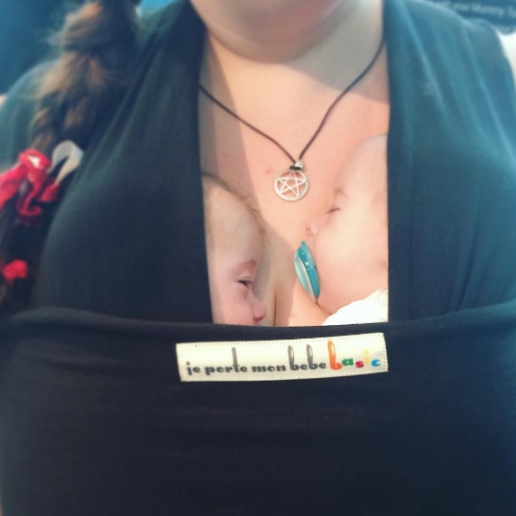
Putting twins in a stretchy wrap
There are many other ways to carry twins as they grow; get in touch with us to get some one to one help or visit our twin support group Peas in a Pod with one of our peer supporters for some simple advice and guidance.
Close Caboo Carrier
This is a semi-structured carrier made of one-way stretchy fabric that has the two cross passes sewn into position, and is tightened once baby is in by pulling any excess fabric through two rings at the side. There is less fabric than the typical stretchy, and it can seem simpler to put on at the beginning, which some people find useful. See the video for how to do it well and safely; the key is to prepare it properly, to fit your baby’s body right at the start. It is popular with those who find the tying and wrapping of a stretchy less to their liking but still wish for the cuddly wrap feel.
Common issues
- Each pass needs to be untwisted and pre-tightened into a hammock shape before putting baby in; too-loose passes at the beginning will mean that baby sinks and slumps.
- Ensure you have the cross piece on the back pulled down to the middle of your back, not resting by your neck.
- Try to get the passes the right snugness for your baby’s body before you put them in.
- Each cross pass must be tightened (or loosened) in strands across the full width of each pass to be effective and avoid slumping.
- The third part must be tied on to ensure good head and neck support.
Some people can find it harder to fold the shoulders out for good airflow and visibility, due to the fixed hem (this is easier with a good two way stretchy wrap). The preflip in the photo tutorial is an excellent solution to this!
Much of the advice and top tips for the stretchy wrap will apply to the Caboo too, see above.
Putting on a Close Carrier
Vija Kangaroo Care Tops
These special items of clothing are designed to hold a small baby close to parent’s chest inside some clever built-in pouches. They are very simple to use, and even come in twin form! More information here
Kangaroo Care shirt
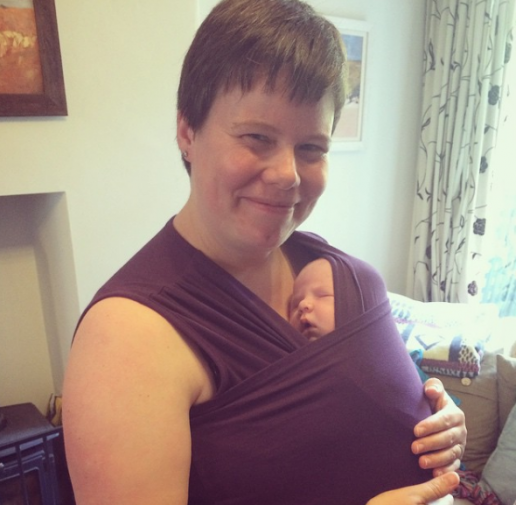
If you need some more support, your local sling educator can be found listed on the Sling Pages.

